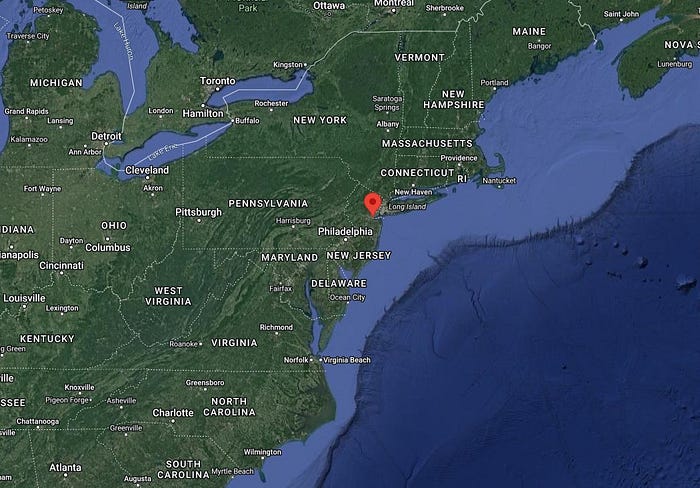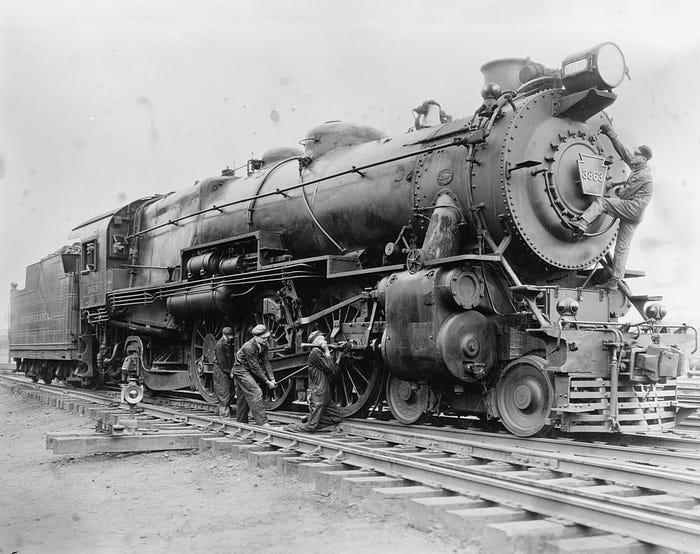
Background
Woodbridge Township is a municipality of 103639 people (as of 2020, 35758 residents in 1950) in the far northeast of the USA, located in the federal state of New Jersey, 32.5km/20mi southwest of New York City (New York) and 101km/63mi northeast of Philadelphia, Pennsylvania (both measurements in linear distance).

At the time of the accident Woodbridge received rail service via the Perth Amboy and Woodbridge Railroad, which today is part of the North Jersey Coast Line, a 168km/105mi electrified main line. At the time of the accident construction of the New Jersey Turnpike, a large highway, was underway at Woodbridge, requiring trains to leave the standard rail line on temporary tracks taking them past the western side of the construction site on an embankment with wooden trestle bridges for underpasses. The temporary track was limited to 40kph/25mph rather than the usual 97kph/60mph.

The Train Involved
Pennsylvania Railroad (PRR) Train number 733 was an express passenger service from Jersey City to Bay Head (both located in the state of New Jersey) and consisted of 11 large express passenger cars pulled by PRR Class K4 number 2445. The Class K4 was a heavy passenger steam locomotive introduced back in 1914, measuring 25.45m/83ft in length at a weight of 234.6 metric tons including the pulled tender. The K4 had 3 driven axles, accompanied by 2 leading and 1 trailing axle, and pulled a four-axle tender carrying up to 15 metric tons of coal. The type had a power output equivalent to 2450kW/3286hp and could reach 140kph/87mph. Locomotive #2445 had been built in 1917. On the day of the accident #2445 was under the command of 57 years old Mister Fitzsimmons, with Mister Bishop working as the conductor. The identity of the fireman is unkown.

The Accident
PRR Train number 733 departs Exchange Place station (at the time the PRR’s main train station) in Jersey City at 5pm on the 6th of February 1951. The train was unusually crowded to workers striking at the nearby Jersey Central Railroad, filling the 11 passenger cars with over 1000 passengers.
A notice had gone out to train crews a week prior, informing them that trains would be directed onto a temporary track and wooden bridges in Woodbridge starting on February 6th at 1:01pm, to allow construction of an overpass on the new New Jersey Turnpike. The temporary track was to be navigated at no more than 40kph/25mph, rather than the usual 97kph/60mph speed limit at Woodbridge. Mister Bishop, conductor on #733, had reminded Mister Fitzsimmons, the driver (referred to in the USA and Canada as the engineer), of the restriction ahead of the train’s departure.
Mister Fitzsimmons fell into long-standing routine over the following 40 minutes, leading to the train approaching the construction site at just over 80kph/50mph. He had simply forgotten about the construction site. Mister Bishop realized that they were travelling at excessive speed around 5:40pm and attempted to reach the emergency brake cord hanging in the train cars, but was unable to do so in the overcrowded interiors. PRR train #733 entered the temporary tracks on the wooden bridge at 5:43pm, going twice as fast as it was meant to. The tracks shifted under the heavy locomotive, forcing the rails apart as the train went around a tight left-hand turn. PRR #2445 almost made it around the turn before falling over and sliding down the embankment to the adjacent road, with the first 8 passenger cars derailing behind it as the track-gauge widened below their wheels. Cars 1 and 2 fell onto their sides and slid to a stop, while 3 and 4 ran into each other as they became airborne and went flying down a 7.9m/26ft high slope. The derailment had destroyed a wooden bridge under the train, causing cars 5 and 6 to end up hanging above a road underpass, with 7 and 8 derailed but somewhat upright behind them. Most direct fatalities occurred in cars 3 and 4 who lost significant survival space in their collision and simultaneous rollover. In total, eventually, 85 people would be listed as deceased with over 500 suffering injuries in what turned out to be the deadliest peacetime rail accident in US history.

Aftermath
The crash shook the ground and shattered several windows on surrounding buildings. The accident occured in a heavily populated area during the day, which meant a lot of residents were around to aid the survivors almost as soon as the accident occured, bridging the minutes until professional responders arrived. While most fatalities had occured in the forward cars due to destruction of the car body and/or impacts with the interior as cars rolled over responders also reported finding dead or dying passengers in the underpass below cars 5 and 6, which were hanging from the remains of a wooden bridge. Faced with injuries not matching ejection from the train the responders soon arrived at a horrifying conclusion. A small number of passengers had survived the derailment and found themselves in damaged cars dangling off a damaged bridge. Looking out the door they saw what they assumed to be a river below and jumped, not knowing that they were looking at rain-soaked asphalt in the fading light. A fatal misinterpretation.

Mister Fitzsimmons survived the accident in the overturned locomotive, being pulled to safety by responding local residents. When questioned by the police he initially insisted that he had obeyed the 40kph/25mph speed limit, pointing to the notice to rail workers his conductor had reminded him off less than an hour prior to the accident. He’s quoted to have claimed “I slowed down when I saw the yellow warning light”. Investigators couldn’t find any sign of flawed construction of the temporary track, and, seeing what had happened along with the degree of destruction, soon zeroed in on excessive speed as the cause of the accident. In fact, Mister Fitzsimmons’ claim about the warning light is what brought investigators on track to find the cause. Simply because there weren’t any. The PRR’s standard procedures saw a notice to rail workers as sufficient, choosing not to install extra signals at such sites to remind train drivers of temporary speed limits. Fitzsimmons eventually admitted that he knew there weren’t any, he had just been sure he did everything right. He was an experienced train driver who had driven trains past the site many times before, and while no intentional speeding could be proven it was assumed that he had just fallen into routine and forgotten about the temporary speed limit. Unfortunately, investigators announced that Mister Bishop likely could have reached and pulled the emergency brake cord, at least significantly reducing the train’s speed, had the train not been as overcrowded. He tried to do everything right but, due to circumstances beyond his control, couldn’t avoid the tragedy.

Immediately after the accident the PRR started utilizing warning signals at temporary slow speed zones, installing several million dollars worth of them within a few weeks. 84 individuals employed by the PRR were charged with manslaughter, but within two years all proceedings were ceased when it came out that the trials would cost the county over 2 million USD (23.4 Million USD/21.37 Million Euros today). Another 75 Million USD (877.3 Million USD/801.2 Million Euros) worth of lawsuits by survivors and relatives were settled out of court, costing the PRR an undisclosed sum.
Mister Fitzsimmons remained employed with with PRR until his retirement in 1953, but he was never put in command of a train again, being kept busy with other tasks instead. He passed away shortly after the accident’s 25th anniversary, at 82 years old. A lot of the accident’s survivors initially remained in contact, starting the “survivor’s club”. The group gathered at the site on the first anniversary of the accident, witnessing the head of the club, Mister Houck, toss a wreath from the rear car of the 5:10pm service (the train which replaced #733’s connection) as it passed the site.

The PRR Class K4 was retired in 1958, with only two of the 425 units made surviving to this day in museal but non-working condition. The PRR as a whole merged with the New york Central Railroad in 1968 to become the Penn Central Transportation Company before disappearing during the formation of Conrail in 1976.
For decades the only physical trace of the accident were cracks in the concrete underpass of Legion Place right where it merges with Fulton Street. New Jersey Transit finally unveiled a bronze plaque dedicated to the accident in 2003, located in a small grassy area 382m/1253ft linear distance north of the site. A second memorial was unveiled in 2013, located 650m/2134ft linear distance northwest of the site in a park. This second memorial provides more extensive information along with two photos of the wreckage and a newspaper headline. Only a small black historical marker stands at the site of the accident today, briefly summarizing what happened. The marker refers to the train as “The Broker”, a nickname it gained due to the high amount of brokers and stock exchange workers usually travelling on it.


Nowadays modern train control systems make accidents caused by excessive speed relatively rare, and no railroad would set up a temporary speed limit with nothing but a brief note to tell crews about it. Crash safety in train cars has also advanced massively since the 1950s, making accidents more survivable. As for those who jumped to their deaths thinking their train car was about to plunge into a river and take them down with it, sadly nothing can really be done there technologically. Confusion, fear and probable panic can easily lead to irrational or simply rushed decision making, which can have terrible consequences.

_______________________________________________________________
A kind reader is posting the installments on reddit for me, I cannot interact with you there but I will read the feedback and corrections. You can find the post right here.
